Rough K Means - Numerical Example
7 likes3,572 views
The document describes the Rough K-Means clustering algorithm. It takes a dataset as input and outputs lower and upper approximations of K clusters. It works as follows: 1. Objects are randomly assigned to initial clusters. Cluster centroids are then computed. 2. Objects are assigned to clusters based on the ratio of their distance to closest versus second closest centroid. Objects on the boundary may belong to multiple clusters. 3. Cluster centroids are recomputed based on the new cluster assignments. The process repeats until cluster centroids converge. An example is provided to illustrate the algorithm on a sample dataset with 6 objects and 2 features.
1 of 4
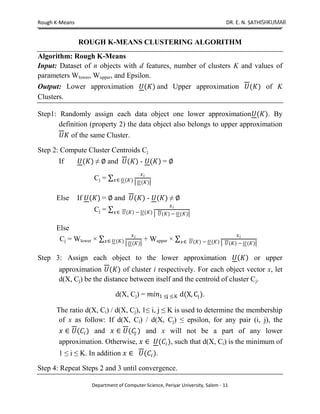
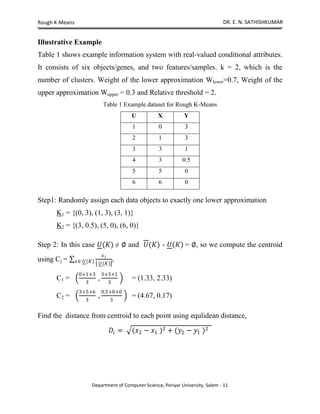
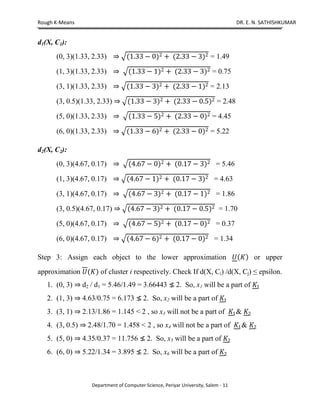
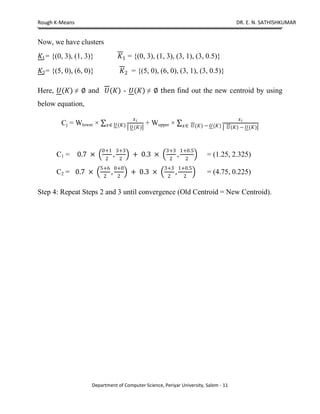
Recommended
Bayes Belief Networks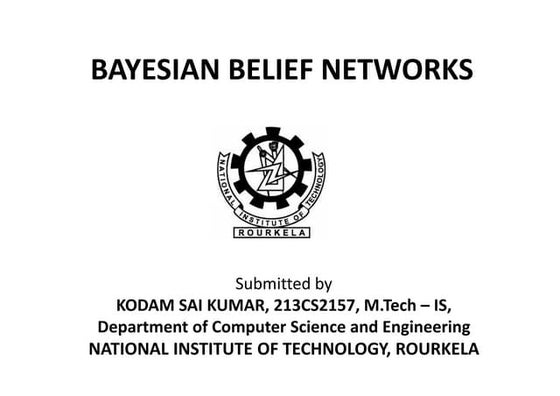



Bayes Belief NetworksSai Kumar Kodam
╠²
The document discusses Bayesian belief networks (BBNs), which represent probabilistic relationships between variables. BBNs consist of a directed acyclic graph showing the dependencies between nodes/variables, and conditional probability tables quantifying the effects. They allow representing conditional independence between non-descendant variables given parents. The document provides an example BBN modeling a home alarm system and neighbors calling police. It then shows calculations to find the probability of a burglary given one neighbor called police using the network. Advantages are handling incomplete data, learning causation, and using prior knowledge, while a disadvantage is more complex graph construction.Shortest path algorithm



Shortest path algorithmSubrata Kumer Paul
╠²
Dijkstra's algorithm is used to find the shortest paths from a source node to all other nodes in a network. It works by marking all nodes as tentative with initial distances from the source set to 0 and others to infinity. It then extracts the closest node, adds it to the shortest path tree, and relaxes distances of its neighbors. This process repeats until all nodes are processed. When applied to the example network, Dijkstra's algorithm finds the shortest path from node A to all others to be A-B=4, A-C=6, A-D=8, A-E=7, A-F=7, A-G=7, and A-H=9.Fuzzy rules and fuzzy reasoning



Fuzzy rules and fuzzy reasoningVeni7
╠²
The document discusses fuzzy sets and fuzzy relations. It defines a fuzzy set as a membership function mapping elements to degrees of membership between 0 and 1. A fuzzy relation is defined as a membership function mapping ordered pairs of elements to degrees of membership. Fuzzy relations can represent concepts like closeness or dependence between elements. The max-min composition is introduced as a way to combine multiple fuzzy relations. Examples are provided to demonstrate fuzzy sets, relations, and their composition.Multi Layer Network



Multi Layer NetworkInternational Islamic University
╠²
The document describes multilayer neural networks and their use for classification problems. It discusses how neural networks can handle continuous-valued inputs and outputs unlike decision trees. Neural networks are inherently parallel and can be sped up through parallelization techniques. The document then provides details on the basic components of neural networks, including neurons, weights, biases, and activation functions. It also describes common network architectures like feedforward networks and discusses backpropagation for training networks.Fuzzy logic Notes AI CSE 8th Sem



Fuzzy logic Notes AI CSE 8th SemDigiGurukul
╠²
This document provides an introduction to fuzzy logic and fuzzy sets. It discusses key concepts such as fuzzy sets having degrees of membership between 0 and 1 rather than binary membership, and fuzzy logic allowing for varying degrees of truth. Examples are given of fuzzy sets representing partially full tumblers and desirable cities to live in. Characteristics of fuzzy sets such as support, crossover points, and logical operations like union and intersection are defined. Applications mentioned include vehicle control systems and appliance control using fuzzy logic to handle imprecise and ambiguous inputs.Fuzzy Membership Function 



Fuzzy Membership Function Siksha 'O' Anusandhan (Deemed to be University )
╠²
This presentation presents Type-1 fuzzy membership function, Type-2 fuzzy membership function (basic level). Hebb network



Hebb networkSiksha 'O' Anusandhan (Deemed to be University )
╠²
This document describes the Hebbian learning rule, a single-layer neural network algorithm. The Hebbian rule updates weights between neurons based on their activation. Given an input, the output neuron's activation and the target output are used to update the weights according to the rule wi new = wi old + xiy. The document provides an example of using the Hebbian rule to train a network to perform the AND logic function over four training iterations. Over the iterations, the weights adjust until the network correctly classifies all four input patterns.Fuzzy relations



Fuzzy relationsnaugariya
╠²
Fuzzy relations, fuzzy graphs, and the extension principle are three important concepts in fuzzy logic. Fuzzy relations generalize classical relations to allow partial membership and describe relationships between objects to varying degrees. Fuzzy graphs describe functional mappings between input and output linguistic variables. The extension principle provides a procedure to extend functions defined on crisp domains to fuzzy domains by mapping fuzzy sets through functions. These concepts form the foundation of fuzzy rules and fuzzy arithmetic.Chapter 4 Classification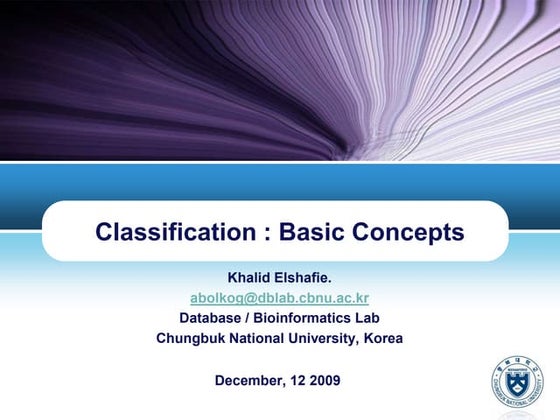



Chapter 4 ClassificationKhalid Elshafie
╠²
This document provides an overview of classification techniques. It defines classification as assigning records to predefined classes based on their attribute values. The key steps are building a classification model from training data and then using the model to classify new, unseen records. Decision trees are discussed as a popular classification method that uses a tree structure with internal nodes for attributes and leaf nodes for classes. The document covers decision tree induction, handling overfitting, and performance evaluation methods like holdout validation and cross-validation.Bayesian networks



Bayesian networksMassimiliano Patacchiola
╠²
In this presentation is given an introduction to Bayesian networks and basic probability theory. Graphical explanation of Bayes' theorem, random variable, conditional and joint probability. Spam classifier, medical diagnosis, fault prediction. The main software for Bayesian Networks are presented. 15 puzzle problem using branch and bound



15 puzzle problem using branch and boundAbhishek Singh
╠²
The document discusses the branch and bound algorithm for solving the 15-puzzle problem. It describes the key components of branch and bound including live nodes, e-nodes, and dead nodes. It also defines the cost function used to evaluate nodes as the sum of the path length and number of misplaced tiles. The algorithm generates all possible child nodes from the current node and prunes the search tree by comparing node costs to avoid exploring subtrees without solutions.K-Nearest Neighbor Classifier



K-Nearest Neighbor ClassifierNeha Kulkarni
╠²
K-Nearest neighbor is one of the most commonly used classifier based in lazy learning. It is one of the most commonly used methods in recommendation systems and document similarity measures. It mainly uses Euclidean distance to find the similarity measures between two data points. K Nearest Neighbors



K Nearest NeighborsTilani Gunawardena PhD(UNIBAS), BSc(Pera), FHEA(UK), CEng, MIESL
╠²
The document discusses the K-nearest neighbors (KNN) algorithm, a simple machine learning algorithm used for classification problems. KNN works by finding the K training examples that are closest in distance to a new data point, and assigning the most common class among those K examples as the prediction for the new data point. The document covers how KNN calculates distances between data points, how to choose the K value, techniques for handling different data types, and the strengths and weaknesses of the KNN algorithm.Deep Feed Forward Neural Networks and Regularization



Deep Feed Forward Neural Networks and RegularizationYan Xu
╠²
Deep feedforward networks use regularization techniques like L2/L1 regularization, dropout, batch normalization, and early stopping to reduce overfitting. They employ techniques like data augmentation to increase the size and variability of training datasets. Backpropagation allows information about the loss to flow backward through the network to efficiently compute gradients and update weights with gradient descent.Cnn



CnnNirthika Rajendran
╠²
Convolutional neural networks (CNNs) learn multi-level features and perform classification jointly and better than traditional approaches for image classification and segmentation problems. CNNs have four main components: convolution, nonlinearity, pooling, and fully connected layers. Convolution extracts features from the input image using filters. Nonlinearity introduces nonlinearity. Pooling reduces dimensionality while retaining important information. The fully connected layer uses high-level features for classification. CNNs are trained end-to-end using backpropagation to minimize output errors by updating weights.Perceptron



PerceptronNagarajan
╠²
1. A perceptron is a basic artificial neural network that can learn linearly separable patterns. It takes weighted inputs, applies an activation function, and outputs a single binary value.
2. Multilayer perceptrons can learn non-linear patterns by using multiple layers of perceptrons with weighted connections between them. They were developed to overcome limitations of single-layer perceptrons.
3. Perceptrons are trained using an error-correction learning rule called the delta rule or the least mean squares algorithm. Weights are adjusted to minimize the error between the actual and target outputs.lazy learners and other classication methods



lazy learners and other classication methodsrajshreemuthiah
╠²
Lazy learning is a machine learning method where generalization of training data is delayed until a query is made, unlike eager learning which generalizes before queries. K-nearest neighbors and case-based reasoning are examples of lazy learners, which store training data and classify new data based on similarity. Case-based reasoning specifically stores prior problem solutions to solve new problems by combining similar past case solutions.Probabilistic Reasoning



Probabilistic ReasoningJunya Tanaka
╠²
This document provides an overview of Chapter 14 on probabilistic reasoning and Bayesian networks from an artificial intelligence textbook. It introduces Bayesian networks as a way to represent knowledge over uncertain domains using directed graphs. Each node corresponds to a variable and arrows represent conditional dependencies between variables. The document explains how Bayesian networks can encode a joint probability distribution and represent conditional independence relationships. It also discusses techniques for efficiently representing conditional distributions in Bayesian networks, including noisy logical relationships and continuous variables. The chapter covers exact and approximate inference methods for Bayesian networks.Perceptron & Neural Networks



Perceptron & Neural NetworksNAGUR SHAREEF SHAIK
╠²
The document provides an overview of perceptrons and neural networks. It discusses how neural networks are modeled after the human brain and consist of interconnected artificial neurons. The key aspects covered include the McCulloch-Pitts neuron model, Rosenblatt's perceptron, different types of learning (supervised, unsupervised, reinforcement), the backpropagation algorithm, and applications of neural networks such as pattern recognition and machine translation.Ensemble learning



Ensemble learningHaris Jamil
╠²
Ensemble Learning is a technique that creates multiple models and then combines them to produce improved results.
Ensemble learning usually produces more accurate solutions than a single model would.
Visit our Website for More Info: https://thetrendshunters.com/custom-acrylic-glass-spotify-music-plaque/Mc culloch pitts neuron



Mc culloch pitts neuronSiksha 'O' Anusandhan (Deemed to be University )
╠²
Here is a MATLAB program to implement logic functions using a McCulloch-Pitts neuron:
% McCulloch-Pitts neuron for logic functions
% Inputs
x1 = 1;
x2 = 0;
% Weights
w1 = 1;
w2 = 1;
% Threshold
theta = 2;
% Net input
net = x1*w1 + x2*w2;
% Activation function
if net >= theta
y = 1;
else
y = 0;
end
% Output
disp(y)
This implements a basic AND logic gate using a McCulloch-Pitts neuron.Feedforward neural network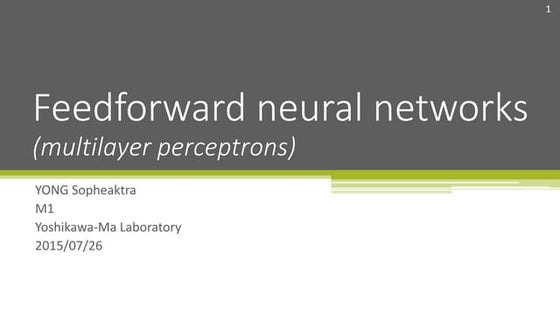



Feedforward neural networkSopheaktra YONG
╠²
This slide is prepared for the lectures-in-turn challenge within the study group of social informatics, kyoto university.Convolutional Neural Networks (CNN)



Convolutional Neural Networks (CNN)Gaurav Mittal
╠²
A comprehensive tutorial on Convolutional Neural Networks (CNN) which talks about the motivation behind CNNs and Deep Learning in general, followed by a description of the various components involved in a typical CNN layer. It explains the theory involved with the different variants used in practice and also, gives a big picture of the whole network by putting everything together.
Next, there's a discussion of the various state-of-the-art frameworks being used to implement CNNs to tackle real-world classification and regression problems.
Finally, the implementation of the CNNs is demonstrated by implementing the paper 'Age ang Gender Classification Using Convolutional Neural Networks' by Hassner (2015).sum of subset problem using Backtracking



sum of subset problem using BacktrackingAbhishek Singh
╠²
Given a set of non-negative integers, and a value sum, determine if there is a subset of the given set with sum equal to given sum.Activation functions



Activation functionsPRATEEK SAHU
╠²
The document discusses various activation functions used in deep learning neural networks including sigmoid, tanh, ReLU, LeakyReLU, ELU, softmax, swish, maxout, and softplus. For each activation function, the document provides details on how the function works and lists pros and cons. Overall, the document provides an overview of common activation functions and considerations for choosing an activation function for different types of deep learning problems.Knapsack problem using fixed tuple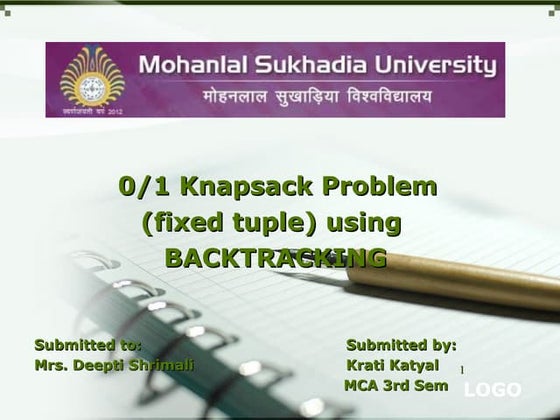



Knapsack problem using fixed tupleMohanlal Sukhadia University (MLSU)
╠²
This document discusses the 0/1 knapsack problem and how it can be solved using backtracking. It begins with an introduction to backtracking and the difference between backtracking and branch and bound. It then discusses the knapsack problem, giving the definitions of the profit vector, weight vector, and knapsack capacity. It explains how the problem is to find the combination of items that achieves the maximum total value without exceeding the knapsack capacity. The document constructs state space trees to demonstrate solving the knapsack problem using backtracking and fixed tuples. It concludes with examples problems and references.Introduction to Linear Discriminant Analysis



Introduction to Linear Discriminant AnalysisJaclyn Kokx
╠²
This document provides an introduction and overview of linear discriminant analysis (LDA). It discusses that LDA is a dimensionality reduction technique used to separate classes of data. The document outlines the 5 main steps to performing LDA: 1) calculating class means, 2) computing scatter matrices, 3) finding linear discriminants using eigenvalues/eigenvectors, 4) determining the transformation subspace, and 5) projecting the data onto the subspace. Examples using the Iris dataset are provided to illustrate how LDA works step-by-step to find projection directions that separate the classes.backpropagation in neural networks



backpropagation in neural networksAkash Goel
╠²
Backpropagation is the algorithm that is used to train modern feed-forwards neural nets. This ppt aims to explain it succinctly.Dynamic Programing_LCS.ppt



Dynamic Programing_LCS.pptmanasgaming4
╠²
The document discusses the longest common subsequence (LCS) problem in bioinformatics. It defines the LCS problem as finding the longest string that is a subsequence of two given DNA strings. It presents an introduction to the problem, defines key terms like subsequence, and describes a brute force approach. The main part of the document presents a dynamic programming solution that uses optimal substructures of prefix sequences to solve the problem efficiently in polynomial time.Rosser's theorem



Rosser's theoremWathna
╠²
This document provides estimates for several number theory functions without assuming the Riemann Hypothesis (RH), including bounds for Žł(x), ╬Ė(x), and the kth prime number pk. The following estimates are derived:
1) ╬Ė(x) - x < 1/36,260x for x > 0.
2) |╬Ė(x) - x| < ╬Ęk x/lnkx for certain values of x, where ╬Ęk decreases as k increases.
3) Estimates are obtained for ╬Ė(pk), the value of ╬Ė at the kth prime number pk, showing ╬Ė(pk) is approximately k ln k + ln2 k - 1.More Related Content
What's hot (20)
Chapter 4 Classification



Chapter 4 ClassificationKhalid Elshafie
╠²
This document provides an overview of classification techniques. It defines classification as assigning records to predefined classes based on their attribute values. The key steps are building a classification model from training data and then using the model to classify new, unseen records. Decision trees are discussed as a popular classification method that uses a tree structure with internal nodes for attributes and leaf nodes for classes. The document covers decision tree induction, handling overfitting, and performance evaluation methods like holdout validation and cross-validation.Bayesian networks



Bayesian networksMassimiliano Patacchiola
╠²
In this presentation is given an introduction to Bayesian networks and basic probability theory. Graphical explanation of Bayes' theorem, random variable, conditional and joint probability. Spam classifier, medical diagnosis, fault prediction. The main software for Bayesian Networks are presented. 15 puzzle problem using branch and bound



15 puzzle problem using branch and boundAbhishek Singh
╠²
The document discusses the branch and bound algorithm for solving the 15-puzzle problem. It describes the key components of branch and bound including live nodes, e-nodes, and dead nodes. It also defines the cost function used to evaluate nodes as the sum of the path length and number of misplaced tiles. The algorithm generates all possible child nodes from the current node and prunes the search tree by comparing node costs to avoid exploring subtrees without solutions.K-Nearest Neighbor Classifier



K-Nearest Neighbor ClassifierNeha Kulkarni
╠²
K-Nearest neighbor is one of the most commonly used classifier based in lazy learning. It is one of the most commonly used methods in recommendation systems and document similarity measures. It mainly uses Euclidean distance to find the similarity measures between two data points. K Nearest Neighbors



K Nearest NeighborsTilani Gunawardena PhD(UNIBAS), BSc(Pera), FHEA(UK), CEng, MIESL
╠²
The document discusses the K-nearest neighbors (KNN) algorithm, a simple machine learning algorithm used for classification problems. KNN works by finding the K training examples that are closest in distance to a new data point, and assigning the most common class among those K examples as the prediction for the new data point. The document covers how KNN calculates distances between data points, how to choose the K value, techniques for handling different data types, and the strengths and weaknesses of the KNN algorithm.Deep Feed Forward Neural Networks and Regularization



Deep Feed Forward Neural Networks and RegularizationYan Xu
╠²
Deep feedforward networks use regularization techniques like L2/L1 regularization, dropout, batch normalization, and early stopping to reduce overfitting. They employ techniques like data augmentation to increase the size and variability of training datasets. Backpropagation allows information about the loss to flow backward through the network to efficiently compute gradients and update weights with gradient descent.Cnn



CnnNirthika Rajendran
╠²
Convolutional neural networks (CNNs) learn multi-level features and perform classification jointly and better than traditional approaches for image classification and segmentation problems. CNNs have four main components: convolution, nonlinearity, pooling, and fully connected layers. Convolution extracts features from the input image using filters. Nonlinearity introduces nonlinearity. Pooling reduces dimensionality while retaining important information. The fully connected layer uses high-level features for classification. CNNs are trained end-to-end using backpropagation to minimize output errors by updating weights.Perceptron



PerceptronNagarajan
╠²
1. A perceptron is a basic artificial neural network that can learn linearly separable patterns. It takes weighted inputs, applies an activation function, and outputs a single binary value.
2. Multilayer perceptrons can learn non-linear patterns by using multiple layers of perceptrons with weighted connections between them. They were developed to overcome limitations of single-layer perceptrons.
3. Perceptrons are trained using an error-correction learning rule called the delta rule or the least mean squares algorithm. Weights are adjusted to minimize the error between the actual and target outputs.lazy learners and other classication methods



lazy learners and other classication methodsrajshreemuthiah
╠²
Lazy learning is a machine learning method where generalization of training data is delayed until a query is made, unlike eager learning which generalizes before queries. K-nearest neighbors and case-based reasoning are examples of lazy learners, which store training data and classify new data based on similarity. Case-based reasoning specifically stores prior problem solutions to solve new problems by combining similar past case solutions.Probabilistic Reasoning



Probabilistic ReasoningJunya Tanaka
╠²
This document provides an overview of Chapter 14 on probabilistic reasoning and Bayesian networks from an artificial intelligence textbook. It introduces Bayesian networks as a way to represent knowledge over uncertain domains using directed graphs. Each node corresponds to a variable and arrows represent conditional dependencies between variables. The document explains how Bayesian networks can encode a joint probability distribution and represent conditional independence relationships. It also discusses techniques for efficiently representing conditional distributions in Bayesian networks, including noisy logical relationships and continuous variables. The chapter covers exact and approximate inference methods for Bayesian networks.Perceptron & Neural Networks



Perceptron & Neural NetworksNAGUR SHAREEF SHAIK
╠²
The document provides an overview of perceptrons and neural networks. It discusses how neural networks are modeled after the human brain and consist of interconnected artificial neurons. The key aspects covered include the McCulloch-Pitts neuron model, Rosenblatt's perceptron, different types of learning (supervised, unsupervised, reinforcement), the backpropagation algorithm, and applications of neural networks such as pattern recognition and machine translation.Ensemble learning



Ensemble learningHaris Jamil
╠²
Ensemble Learning is a technique that creates multiple models and then combines them to produce improved results.
Ensemble learning usually produces more accurate solutions than a single model would.
Visit our Website for More Info: https://thetrendshunters.com/custom-acrylic-glass-spotify-music-plaque/Mc culloch pitts neuron



Mc culloch pitts neuronSiksha 'O' Anusandhan (Deemed to be University )
╠²
Here is a MATLAB program to implement logic functions using a McCulloch-Pitts neuron:
% McCulloch-Pitts neuron for logic functions
% Inputs
x1 = 1;
x2 = 0;
% Weights
w1 = 1;
w2 = 1;
% Threshold
theta = 2;
% Net input
net = x1*w1 + x2*w2;
% Activation function
if net >= theta
y = 1;
else
y = 0;
end
% Output
disp(y)
This implements a basic AND logic gate using a McCulloch-Pitts neuron.Feedforward neural network



Feedforward neural networkSopheaktra YONG
╠²
This slide is prepared for the lectures-in-turn challenge within the study group of social informatics, kyoto university.Convolutional Neural Networks (CNN)



Convolutional Neural Networks (CNN)Gaurav Mittal
╠²
A comprehensive tutorial on Convolutional Neural Networks (CNN) which talks about the motivation behind CNNs and Deep Learning in general, followed by a description of the various components involved in a typical CNN layer. It explains the theory involved with the different variants used in practice and also, gives a big picture of the whole network by putting everything together.
Next, there's a discussion of the various state-of-the-art frameworks being used to implement CNNs to tackle real-world classification and regression problems.
Finally, the implementation of the CNNs is demonstrated by implementing the paper 'Age ang Gender Classification Using Convolutional Neural Networks' by Hassner (2015).sum of subset problem using Backtracking



sum of subset problem using BacktrackingAbhishek Singh
╠²
Given a set of non-negative integers, and a value sum, determine if there is a subset of the given set with sum equal to given sum.Activation functions



Activation functionsPRATEEK SAHU
╠²
The document discusses various activation functions used in deep learning neural networks including sigmoid, tanh, ReLU, LeakyReLU, ELU, softmax, swish, maxout, and softplus. For each activation function, the document provides details on how the function works and lists pros and cons. Overall, the document provides an overview of common activation functions and considerations for choosing an activation function for different types of deep learning problems.Knapsack problem using fixed tuple



Knapsack problem using fixed tupleMohanlal Sukhadia University (MLSU)
╠²
This document discusses the 0/1 knapsack problem and how it can be solved using backtracking. It begins with an introduction to backtracking and the difference between backtracking and branch and bound. It then discusses the knapsack problem, giving the definitions of the profit vector, weight vector, and knapsack capacity. It explains how the problem is to find the combination of items that achieves the maximum total value without exceeding the knapsack capacity. The document constructs state space trees to demonstrate solving the knapsack problem using backtracking and fixed tuples. It concludes with examples problems and references.Introduction to Linear Discriminant Analysis



Introduction to Linear Discriminant AnalysisJaclyn Kokx
╠²
This document provides an introduction and overview of linear discriminant analysis (LDA). It discusses that LDA is a dimensionality reduction technique used to separate classes of data. The document outlines the 5 main steps to performing LDA: 1) calculating class means, 2) computing scatter matrices, 3) finding linear discriminants using eigenvalues/eigenvectors, 4) determining the transformation subspace, and 5) projecting the data onto the subspace. Examples using the Iris dataset are provided to illustrate how LDA works step-by-step to find projection directions that separate the classes.backpropagation in neural networks



backpropagation in neural networksAkash Goel
╠²
Backpropagation is the algorithm that is used to train modern feed-forwards neural nets. This ppt aims to explain it succinctly.Similar to Rough K Means - Numerical Example (20)
Dynamic Programing_LCS.ppt



Dynamic Programing_LCS.pptmanasgaming4
╠²
The document discusses the longest common subsequence (LCS) problem in bioinformatics. It defines the LCS problem as finding the longest string that is a subsequence of two given DNA strings. It presents an introduction to the problem, defines key terms like subsequence, and describes a brute force approach. The main part of the document presents a dynamic programming solution that uses optimal substructures of prefix sequences to solve the problem efficiently in polynomial time.Rosser's theorem



Rosser's theoremWathna
╠²
This document provides estimates for several number theory functions without assuming the Riemann Hypothesis (RH), including bounds for Žł(x), ╬Ė(x), and the kth prime number pk. The following estimates are derived:
1) ╬Ė(x) - x < 1/36,260x for x > 0.
2) |╬Ė(x) - x| < ╬Ęk x/lnkx for certain values of x, where ╬Ęk decreases as k increases.
3) Estimates are obtained for ╬Ė(pk), the value of ╬Ė at the kth prime number pk, showing ╬Ė(pk) is approximately k ln k + ln2 k - 1.On approximate bounds of zeros of polynomials within



On approximate bounds of zeros of polynomials withineSAT Publishing House
╠²
IJRET : International Journal of Research in Engineering and Technology is an international peer reviewed, online journal published by eSAT Publishing House for the enhancement of research in various disciplines of Engineering and Technology. The aim and scope of the journal is to provide an academic medium and an important reference for the advancement and dissemination of research results that support high-level learning, teaching and research in the fields of Engineering and Technology. We bring together Scientists, Academician, Field Engineers, Scholars and Students of related fields of Engineering and TechnologyResponse Surface in Tensor Train format for Uncertainty Quantification



Response Surface in Tensor Train format for Uncertainty QuantificationAlexander Litvinenko
╠²
We apply low-rank Tensor Train format to solve PDEs with uncertain coefficients. First, we approximate uncertain permeability coefficient in TT format, then the operator and then apply iterations to solve stochastic Galerkin system.Some properties of two-fuzzy Nor med spaces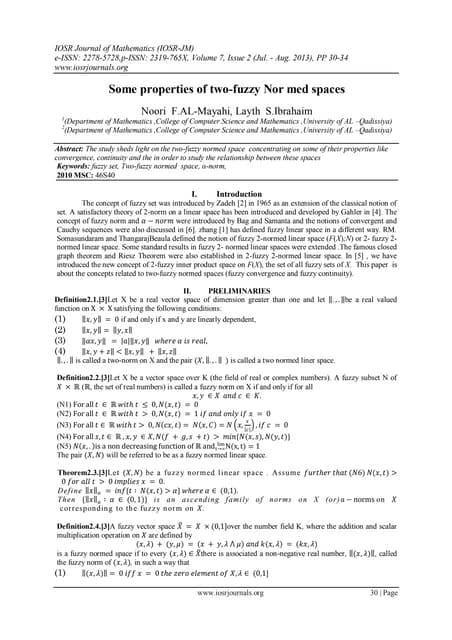



Some properties of two-fuzzy Nor med spacesIOSR Journals
╠²
The study sheds light on the two-fuzzy normed space concentrating on some of their properties like convergence, continuity and the in order to study the relationship between these spacesmachinelearning project



machinelearning projectLianli Liu
╠²
This document discusses subspace clustering with missing data. It summarizes two algorithms for solving this problem: 1) an EM-type algorithm that formulates the problem probabilistically and iteratively estimates the subspace parameters using an EM approach. 2) A k-means form algorithm called k-GROUSE that alternates between assigning vectors to subspaces based on projection residuals and updating each subspace using incremental gradient descent on the Grassmannian manifold. It also discusses the sampling complexity results from a recent paper, showing subspace clustering is possible without an impractically large sample size.Decoding BCH-Code.pdf



Decoding BCH-Code.pdfKundanSasi
╠²
The document describes the decoding of BCH codes through syndrome calculation and Berlekamp's iterative algorithm. It discusses how the syndrome is calculated from the received vector, and how the syndrome components relate to the error pattern. Berlekamp's algorithm determines the error-location polynomial Žā(x) iteratively by ensuring its coefficients satisfy the Newton identities relating it to the syndrome at each step, until Žā(x) is obtained after 2t steps.Identification of the Mathematical Models of Complex Relaxation Processes in ...



Identification of the Mathematical Models of Complex Relaxation Processes in ...Vladimir Bakhrushin
╠²
The approach to solving the problem of complex relaxation spectra is presented.
Presentation for the XI International Conference on Defect interaction and anelastic phenomena in solids. Tula, 2007.1 illustrating limit of a function



1 illustrating limit of a functionJRCatador
╠²
The document contains learning objectives and examples for teaching students about limits of functions. It includes:
1) Examples of finding the limit of functions as x approaches specific values using tables of values. This shows that as x gets closer to the given value, f(x) gets closer to the limit value.
2) A definition of limit that states the limit of a function f(x) as x approaches a is L if, given any positive epsilon, there exists a delta such that if the difference between x and a is less than delta, the difference between f(x) and L will be less than epsilon.
3) Three theorems about limits: the limit of a sum or difference is the51554 0131469657 ism-13



51554 0131469657 ism-13Carlos Fuentes
╠²
1. This document provides a review of concepts and sample problems related to multiple integrals. It covers topics such as iterated integrals, changing the order of integration, and evaluating double integrals over various regions.
2. The problem set contains 14 problems evaluating double integrals over different regions using techniques like iterated integration and changing the order of integration.
3. Multiple integrals are used to find volumes, masses, moments, and other physical quantities over regions in 2D and 3D space. The document demonstrates how to set up and evaluate multiple integrals to solve applied problems.Random variables.pptx



Random variables.pptxSKalyani_cbe
╠²
The document discusses probability and random processes. It defines random variables as functions that assign real numbers to elements of a sample space from a random experiment. Random variables can be discrete or continuous. Discrete random variables take countable values while continuous random variables take all values in an interval. Probability mass functions define probabilities for discrete random variables and probability density functions define probabilities for continuous random variables. The cumulative distribution function gives the probability that a random variable is less than or equal to a value. Examples are provided to illustrate discrete and continuous random variables and their probability functions.Applied Mathematics Multiple Integration by Mrs. Geetanjali P.Kale.pdf



Applied Mathematics Multiple Integration by Mrs. Geetanjali P.Kale.pdfGeetanjaliRao6
╠²
In mathematics (specifically multivariable calculus), a Multiple Integral is a Definite Integral of a function of several real variables, for instance, f(x, y) or f(x, y, z). Integrals of a function of two variables over a region in (the real-number plane) are called Double Integrals, and integrals of a function of three variables over a region in (real-number 3D space) are called Triple Integrals. For multiple integrals of a single-variable function, see the Cauchy formula for repeated integration.Higher order derivatives for N -body simulations



Higher order derivatives for N -body simulationsKeigo Nitadori
╠²
This document discusses higher order derivatives that are useful for N-body simulations. It presents formulas for calculating higher order derivatives of power functions like y=xn, and applies this to derivatives of gravitational force f=mr-3. Specifically:
1) It derives recursive formulas for calculating higher order derivatives of power functions y=xn in terms of previous derivatives.
2) It applies these formulas to calculate derivatives of the gravitational force f=mr-3 in terms of derivatives of r and q=r-3/2.
3) It also describes an alternative approach by Le Guyader (1993) for calculating derivatives of r and q in terms of dot products of r with itself.Cluster



ClusterSvetlana Slavnic
╠²
This document describes a method called "k-means" for partitioning multivariate data into k groups based on minimizing within-group variance. It can be used for applications like classification, prediction, and testing independence among variables. The k-means process works by starting each group with a single data point, then iteratively assigning new points to the nearest group and updating group means. The document proves that the k-means values converge almost surely to a set of distinct points that minimize within-group variance. It also describes some applications and extensions of the k-means method.CBSE Mathematics sample question paper with marking scheme



CBSE Mathematics sample question paper with marking schemePratima Nayak ,Kendriya Vidyalaya Sangathan
╠²
The document is the marking scheme for a mathematics exam consisting of 26 questions divided into 3 sections. Section A has 6 one-mark questions, Section B has 13 four-mark questions, and Section C has 7 six-mark questions. For questions involving calculus, the marking scheme provides the full working and steps to arrive at the solution. For other questions it states the final answer or shows a short reasoning to justify the answer. The marking scheme also sometimes explains the concepts involved in the question to help examiners understand the approach and marking.lec33.ppt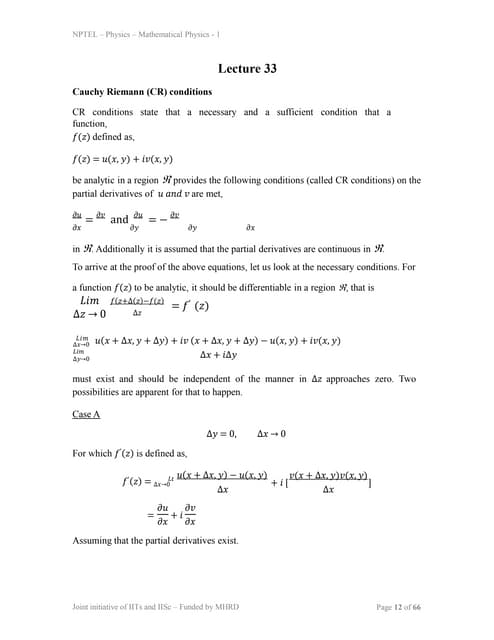



lec33.pptRai Saheb Bhanwar Singh College Nasrullaganj
╠²
The Cauchy Riemann (CR) conditions provide a necessary and sufficient condition for a function f(z) = u(x, y) + iv(x, y) to be analytic in a region. The CR conditions require that the partial derivatives of u and v satisfy Ōłéu/Ōłéx = Ōłév/Ōłéy and Ōłéu/Ōłéy = -Ōłév/Ōłéx. If a function satisfies these conditions at all points in a region, then it is analytic in that region. The document proves this using cases where Ōłåy = 0 and Ōłåx = 0, showing the derivatives must be equal. Examples are provided to demonstrate checking functions for analyticA05330107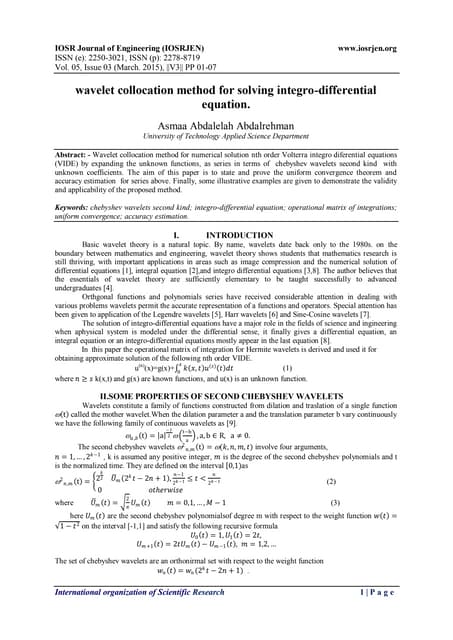



A05330107IOSR-JEN
╠²
1) The document presents a wavelet collocation method for numerically solving nth order Volterra integro-differential equations. It expands the unknown function as a series of Chebyshev wavelets of the second kind with unknown coefficients.
2) It states and proves a uniform convergence theorem that establishes the convergence of approximating the solution using truncated Chebyshev wavelet series expansions.
3) The paper demonstrates the validity and applicability of the proposed method through some illustrative examples of solving integro-differential equations using the Chebyshev wavelet collocation approach.A Probabilistic Algorithm for Computation of Polynomial Greatest Common with ...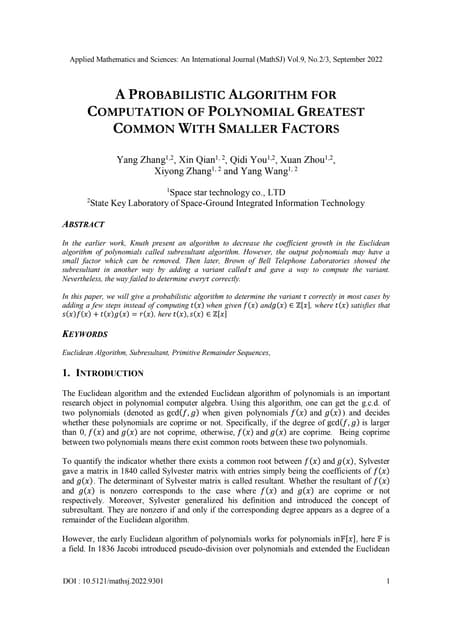



A Probabilistic Algorithm for Computation of Polynomial Greatest Common with ...mathsjournal
╠²
- The document presents a probabilistic algorithm for computing the polynomial greatest common divisor (PGCD) with smaller factors.
- It summarizes previous work on the subresultant algorithm for computing PGCD and discusses its limitations, such as not always correctly determining the variant Žä.
- The new algorithm aims to determine Žä correctly in most cases when given two polynomials f(x) and g(x). It does so by adding a few steps instead of directly computing the polynomial t(x) in the relation s(x)f(x) + t(x)g(x) = r(x).A PROBABILISTIC ALGORITHM FOR COMPUTATION OF POLYNOMIAL GREATEST COMMON WITH ...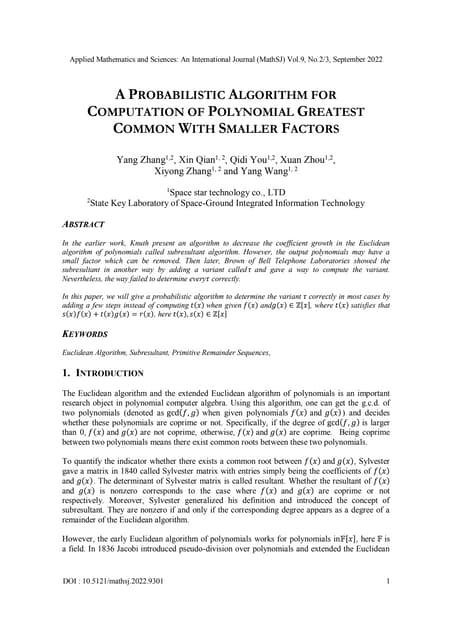



A PROBABILISTIC ALGORITHM FOR COMPUTATION OF POLYNOMIAL GREATEST COMMON WITH ...mathsjournal
╠²
In the earlier work, Knuth present an algorithm to decrease the coefficient growth in the Euclidean
algorithm of polynomials called subresultant algorithm. However, the output polynomials may have a
small factor which can be removed. Then later, Brown of Bell Telephone Laboratories showed the
subresultant in another way by adding a variant called أŠand gave a way to compute the variant.
Nevertheless, the way failed to determine everyأŠcorrectly.
In this paper, we will give a probabilistic algorithm to determine the variant أŠcorrectly in most cases by
adding a few steps instead of computing ØæĪ(Øæź) when given Øæō(Øæź) andØæö(Øæź) Ōłł Ōäż[Øæź], where ØæĪ(Øæź) satisfies that
ØæĀ(Øæź)Øæō(Øæź) + ØæĪ(Øæź)Øæö(Øæź) = Øæ¤(Øæź), here ØæĪ(Øæź), ØæĀ(Øæź) Ōłł Ōäż[Øæź]
Identification of the Mathematical Models of Complex Relaxation Processes in ...



Identification of the Mathematical Models of Complex Relaxation Processes in ...Vladimir Bakhrushin
╠²
CBSE Mathematics sample question paper with marking scheme



CBSE Mathematics sample question paper with marking schemePratima Nayak ,Kendriya Vidyalaya Sangathan
╠²
Recently uploaded (20)
Dr. Ansari Khurshid Ahmed- Factors affecting Validity of a Test.pptx



Dr. Ansari Khurshid Ahmed- Factors affecting Validity of a Test.pptxKhurshid Ahmed Ansari
╠²
Validity is an important characteristic of a test. A test having low validity is of little use. Validity is the accuracy with which a test measures whatever it is supposed to measure. Validity can be low, moderate or high. There are many factors which affect the validity of a test. If these factors are controlled, then the validity of the test can be maintained to a high level. In the power point presentation, factors affecting validity are discussed with the help of concrete examples.Year 10 The Senior Phase Session 3 Term 1.pptx



Year 10 The Senior Phase Session 3 Term 1.pptxmansk2
╠²
Year 10 The Senior Phase Session 3 Term 1.pptxAzure Administrator Interview Questions By ScholarHat



Azure Administrator Interview Questions By ScholarHatScholarhat
╠²
Azure Administrator Interview Questions By ScholarHatHannah Borhan and Pietro Gagliardi OECD present 'From classroom to community ...



Hannah Borhan and Pietro Gagliardi OECD present 'From classroom to community ...EduSkills OECD
╠²
Hannah Borhan, Research Assistant, OECD Education and Skills Directorate and Pietro Gagliardi, Policy Analyst, OECD Public Governance Directorate present at the OECD webinar 'From classroom to community engagement: Promoting active citizenship among young people" on 25 February 2025. You can find the recording of the webinar on the website https://oecdedutoday.com/webinars/
BISNIS BERKAH BERANGKAT KE MEKKAH ISTIKMAL SYARIAH



BISNIS BERKAH BERANGKAT KE MEKKAH ISTIKMAL SYARIAHcoacharyasetiyaki
╠²
BISNIS BERKAH BERANGKAT KE MEKKAH ISTIKMAL SYARIAHChapter 2. Strategic Management: Corporate Governance.pdf



Chapter 2. Strategic Management: Corporate Governance.pdfRommel Regala
╠²
This course provides students with a comprehensive understanding of strategic management principles, frameworks, and applications in business. It explores strategic planning, environmental analysis, corporate governance, business ethics, and sustainability. The course integrates Sustainable Development Goals (SDGs) to enhance global and ethical perspectives in decision-making.Intellectual Honesty & Research Integrity.pptx



Intellectual Honesty & Research Integrity.pptxNidhiSharma495177
╠²
Research Publication & Ethics contains a chapter on Intellectual Honesty and Research Integrity.
Different case studies of intellectual dishonesty and integrity were discussed.Interim Guidelines for PMES-DM-17-2025-PPT.pptx



Interim Guidelines for PMES-DM-17-2025-PPT.pptxsirjeromemanansala
╠²
This is the latest issuance on PMES as replacement of RPMS. Kindly message me to gain full access of the presentation. Effective Product Variant Management in Odoo 18



Effective Product Variant Management in Odoo 18Celine George
╠²
In this slide weŌĆÖll discuss on the effective product variant management in Odoo 18. Odoo concentrates on managing product variations and offers a distinct area for doing so. Product variants provide unique characteristics like size and color to single products, which can be managed at the product template level for all attributes and variants or at the variant level for individual variants.RRB ALP CBT 2 RAC Question Paper MCQ (Railway Assistant Loco Pilot)



RRB ALP CBT 2 RAC Question Paper MCQ (Railway Assistant Loco Pilot)SONU HEETSON
╠²
RRB ALP CBT 2 RAC Question Paper MCQ PDF Free Download. Railway Assistant Loco Pilot Mechanic Refrigeration and Air Conditioning Important Questions.ASP.NET Interview Questions PDF By ScholarHat



ASP.NET Interview Questions PDF By ScholarHatScholarhat
╠²
ASP.NET Interview Questions PDF By ScholarHatOne Click RFQ Cancellation in Odoo 18 - Odoo ║▌║▌▀Żs



One Click RFQ Cancellation in Odoo 18 - Odoo ║▌║▌▀ŻsCeline George
╠²
In this slide, weŌĆÖll discuss the one click RFQ Cancellation in odoo 18. One-Click RFQ Cancellation in Odoo 18 is a feature that allows users to quickly and easily cancel Request for Quotations (RFQs) with a single click.ASP.NET Web API Interview Questions By Scholarhat



ASP.NET Web API Interview Questions By ScholarhatScholarhat
╠²
ASP.NET Web API Interview Questions By ScholarhatRough K Means - Numerical Example
- 1. Rough K-Means DR. E. N. SATHISHKUMAR Department of Computer Science, Periyar University, Salem - 11 ROUGH K-MEANS CLUSTERING ALGORITHM Algorithm: Rough K-Means Input: Dataset of n objects with d features, number of clusters K and values of parameters Wlower, Wupper, and Epsilon. Output: Lower approximation Øæł(ØÉŠ) and Upper approximation Øæł(ØÉŠ) of K Clusters. Step1: Randomly assign each data object one lower approximationØæł(ØÉŠ). By definition (property 2) the data object also belongs to upper approximation ØæłØÉŠ of the same Cluster. Step 2: Compute Cluster Centroids Cj If Øæł(ØÉŠ) ŌēĀ Ōłģ and Øæł(ØÉŠ) - Øæł(ØÉŠ) = Ōłģ Cj = Øæź Øæ¢ Øæł(ØÉŠ)ØæźŌłł Øæł(ØÉŠ) Else If Øæł(ØÉŠ) = Ōłģ and Øæł(ØÉŠ) - Øæł(ØÉŠ) ŌēĀ Ōłģ Cj = Øæź Øæ¢ Øæł(ØÉŠ) ŌłÆ Øæł(ØÉŠ)ØæźŌłł Øæł(ØÉŠ) ŌłÆ Øæł(ØÉŠ) Else Cj = Wlower ├Ś Øæź Øæ¢ Øæł(ØÉŠ)ØæźŌłł Øæł(ØÉŠ) + Wupper ├Ś Øæź Øæ¢ Øæł(ØÉŠ) ŌłÆ Øæł(ØÉŠ)ØæźŌłł Øæł(ØÉŠ) ŌłÆ Øæł(ØÉŠ) Step 3: Assign each object to the lower approximation Øæł ØÉŠ or upper approximation Øæł(ØÉŠ) of cluster i respectively. For each object vector x, let d(X, Cj) be the distance between itself and the centroid of cluster Cj. d(X, Cj) = ØæÜØæ¢Øæø1 Ōēżj ŌēżK d(X, Cj). The ratio d(X, Ci) / d(X, Cj), 1Ōēż i, j Ōēż K is used to determine the membership of x as follow: If d(X, Ci) / d(X, Cj) Ōēż epsilon, for any pair (i, j), the Øæź Ōłł Øæł(ØÉČØæ¢) and Øæź Ōłł Øæł(ØÉČØæŚ ) and x will not be a part of any lower approximation. Otherwise, Øæź Ōłł Øæł(ØÉČØæ¢), such that d(X, Ci) is the minimum of 1 Ōēż i Ōēż K. In addition Øæź Ōłł Øæł(ØÉČØæ¢). Step 4: Repeat Steps 2 and 3 until convergence.
- 2. Rough K-Means DR. E. N. SATHISHKUMAR Department of Computer Science, Periyar University, Salem - 11 Illustrative Example Table 1 shows example information system with real-valued conditional attributes. It consists of six objects/genes, and two features/samples. k = 2, which is the number of clusters. Weight of the lower approximation Wlower=0.7, Weight of the upper approximation Wupper = 0.3 and Relative threshold = 2. Table 1 Example dataset for Rough K-Means U X Y 1 0 3 2 1 3 3 3 1 4 3 0.5 5 5 0 6 6 0 Step1: Randomly assign each data objects to exactly one lower approximation K1 = {(0, 3), (1, 3), (3, 1)} K2 = {(3, 0.5), (5, 0), (6, 0)} Step 2: In this case Øæł(ØÉŠ) ŌēĀ Ōłģ and Øæł(ØÉŠ) - Øæł(ØÉŠ) = Ōłģ, so we compute the centroid using Cj = Øæź Øæ¢ Øæł(ØÉŠ)ØæźŌłł Øæł(ØÉŠ) , C1 = 0+1+3 3 , 3+3+1 3 = (1.33, 2.33) C2 = 3+5+6 3 , 0.5+0+0 3 = (4.67, 0.17) Find the distance from centroid to each point using equlidean distance, ØÉĘØæ¢ = (Øæź2 ŌłÆ Øæź1 )2 + (Øæ”2 ŌłÆ Øæ”1 )2
- 3. Rough K-Means DR. E. N. SATHISHKUMAR Department of Computer Science, Periyar University, Salem - 11 d1(X, C1): (0, 3)(1.33, 2.33) ŌćÆ (1.33 ŌłÆ 0)2 + (2.33 ŌłÆ 3)2 = 1.49 (1, 3)(1.33, 2.33) ŌćÆ (1.33 ŌłÆ 1)2 + (2.33 ŌłÆ 3)2 = 0.75 (3, 1)(1.33, 2.33) ŌćÆ (1.33 ŌłÆ 3)2 + (2.33 ŌłÆ 1)2 = 2.13 (3, 0.5)(1.33, 2.33) ŌćÆ (1.33 ŌłÆ 3)2 + (2.33 ŌłÆ 0.5)2 = 2.48 (5, 0)(1.33, 2.33) ŌćÆ (1.33 ŌłÆ 5)2 + (2.33 ŌłÆ 0)2 = 4.45 (6, 0)(1.33, 2.33) ŌćÆ (1.33 ŌłÆ 6)2 + (2.33 ŌłÆ 0)2 = 5.22 d2(X, C2): (0, 3)(4.67, 0.17) ŌćÆ (4.67 ŌłÆ 0)2 + (0.17 ŌłÆ 3)2 = 5.46 (1, 3)(4.67, 0.17) ŌćÆ (4.67 ŌłÆ 1)2 + (0.17 ŌłÆ 3)2 = 4.63 (3, 1)(4.67, 0.17) ŌćÆ (4.67 ŌłÆ 3)2 + (0.17 ŌłÆ 1)2 = 1.86 (3, 0.5)(4.67, 0.17) ŌćÆ (4.67 ŌłÆ 3)2 + (0.17 ŌłÆ 0.5)2 = 1.70 (5, 0)(4.67, 0.17) ŌćÆ (4.67 ŌłÆ 5)2 + (0.17 ŌłÆ 0)2 = 0.37 (6, 0)(4.67, 0.17) ŌćÆ (4.67 ŌłÆ 6)2 + (0.17 ŌłÆ 0)2 = 1.34 Step 3: Assign each object to the lower approximation Øæł ØÉŠ or upper approximation Øæł(ØÉŠ) of cluster i respectively. Check If d(X, Ci) /d(X, Cj) Ōēż epsilon. 1. (0, 3) ŌćÆ d2 / d1 = 5.46/1.49 = 3.66443 Ōē░ 2. So, x1 will be a part of ØÉŠ1 2. (1, 3) ŌćÆ 4.63/0.75 = 6.173 Ōē░ 2. So, x2 will be a part of ØÉŠ1 3. (3, 1) ŌćÆ 2.13/1.86 = 1.145 < 2 , so x3 will not be a part of ØÉŠ1& ØÉŠ2 4. (3, 0.5) ŌćÆ 2.48/1.70 = 1.458 < 2 , so x4 will not be a part of ØÉŠ1& ØÉŠ2 5. (5, 0) ŌćÆ 4.35/0.37 = 11.756 Ōē░ 2. So, x5 will be a part of ØÉŠ2 6. (6, 0) ŌćÆ 5.22/1.34 = 3.895 Ōē░ 2. So, x6 will be a part of ØÉŠ2
- 4. Rough K-Means DR. E. N. SATHISHKUMAR Department of Computer Science, Periyar University, Salem - 11 Now, we have clusters ØÉŠ1= {(0, 3), (1, 3)} ØÉŠ1 = {(0, 3), (1, 3), (3, 1), (3, 0.5)} ØÉŠ2= {(5, 0), (6, 0)} ØÉŠ2 = {(5, 0), (6, 0), (3, 1), (3, 0.5)} Here, Øæł(ØÉŠ) ŌēĀ Ōłģ and Øæł(ØÉŠ) - Øæł(ØÉŠ) ŌēĀ Ōłģ then find out the new centroid by using below equation, Cj = Wlower ├Ś Øæź Øæ¢ Øæł(ØÉŠ)ØæźŌłł Øæł(ØÉŠ) + Wupper ├Ś Øæź Øæ¢ Øæł(ØÉŠ) ŌłÆ Øæł(ØÉŠ)ØæźŌłł Øæł(ØÉŠ) ŌłÆ Øæł(ØÉŠ) C1 = 0.7 ├Ś 0+1 2 , 3+3 2 + 0.3 ├Ś 3+3 2 , 1+0.5 2 = (1.25, 2.325) C2 = 0.7 ├Ś 5+6 2 , 0+0 2 + 0.3 ├Ś 3+3 2 , 1+0.5 2 = (4.75, 0.225) Step 4: Repeat Steps 2 and 3 until convergence (Old Centroid = New Centroid).







